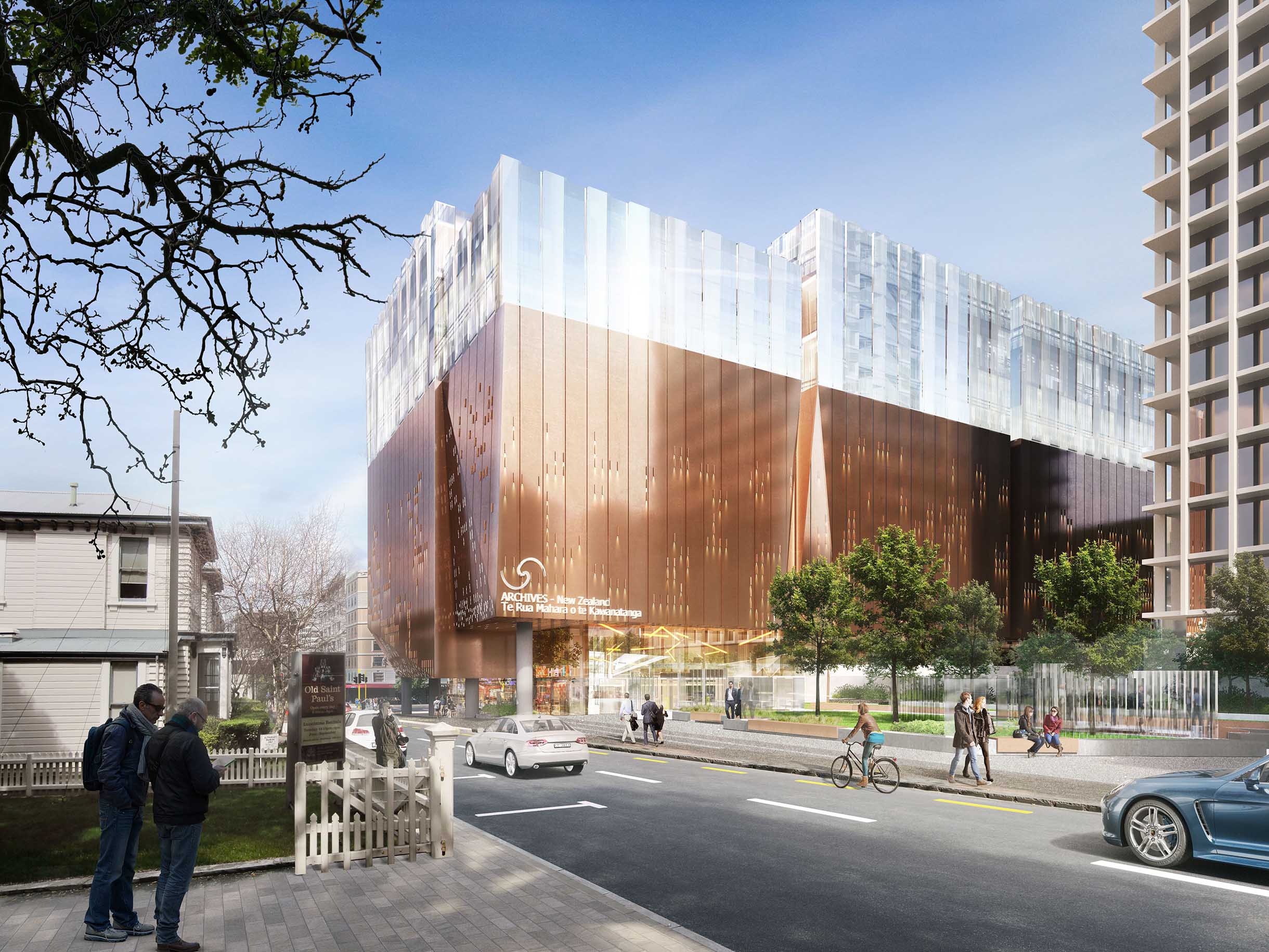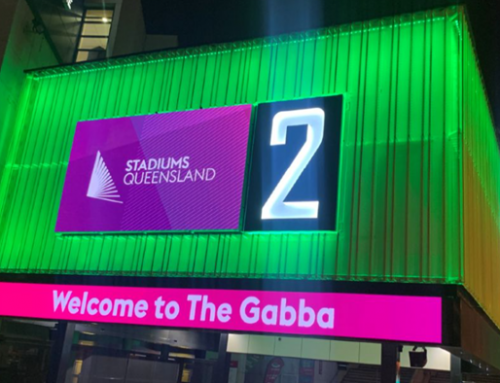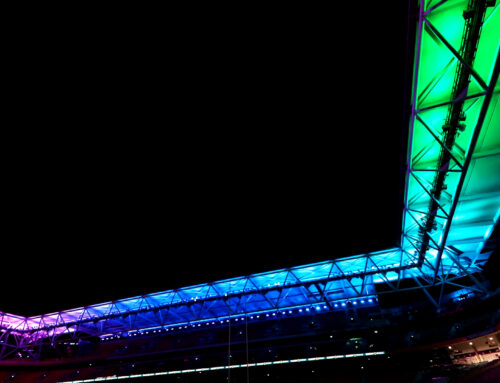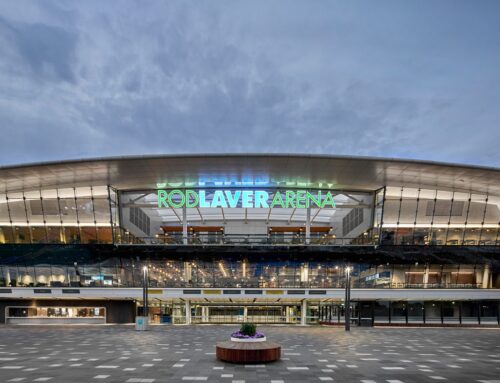A project of national significance, the new Heke Rua Archives New Zealand building in Wellington is purpose designed to ensure New Zealand’s (NZ) growing collection of archives has a home that is fit for purpose.
With the design created with a te ao Māori world view, the state-of-the-art facility will enable conservation and care of Aotearoa’s important historical and cultural artefacts (including the Te Tiriti o Waitangi/Treaty of Waitangi), while providing greater public access to its collection of stories, taonga and heritage.
One of the taonga of the Tiriti o Waitangi is kaitiakitanga, meaning stewardship, protection and preservation. The facility is demonstrating kaitiakitanga through a targeted 5 Star Green Star Design & As Built rating, focusing on improved climate resilience, reducing operational carbon and improving the health and wellbeing of occupants.
The new building boasts 19,000 m² of floor space across 9 levels plus a large basement, and includes the following key features:
- Specialised lighting throughout that will not deteriorate archival material. A quarantine and receiving area comprised of air-locked laboratories and circadian lighting.
- Seminar and meeting rooms alongside exhibition space.
- Public reading rooms and storage of large art within a controlled environment with low humidity requirements. Lighting is DALI controllable with dimmed and presentation pre-set scenes via a local lighting control panel. High CRI low blue spectrum track mounted spot lighting will be provided across a large format viewing zone with pre-set presentation scenes.
- Cool rooms with low temperatures and dry conditions required for preservation of film archives, that use desiccant dehumidification rather than a cooling coil to achieve this result.
- Archive storage in a controlled environment with low humidity requirements. Shelving lighting controlled via two-way switching, with absence detection via corridor occupancy sensors.
- Photographic and digital preservation together with a laboratories area with multiple fume cupboards throughout. The mechanical ventilation provides the required environmental condition to each zone.
- Lighting throughout digitisation, conservation, preservation, quarantine and assessment spaces will be tuneable, white 2700K – 6500K dimmable and grouped into local switching zones.
- Pre-set lighting scenes are enabled via local lighting control panel to meet Green Star localised lighting control requirements.
A link bridge to the National Library provides pedestrian access and transfer of archival material, combining the two buildings into an archival precinct.
Designed to be the most resilient structure in NZ, the base isolators are some of the largest ever produced allowing the building to move up to 1,500 mm in an earthquake. Despite the basement space needed to house the isolators, the building services were arranged around them to make the area fully functional for receiving, quarantine and packaging of incoming artifacts. Partitions throughout the building were designed to accommodate seismic movement, with the building services design integrated in the concept.
NDY also undertook a climate change risk assessment to consider the project’s design and longevity based on the predicted climate change models over the building’s expected life. Some examples of design resiliency include:
- The ability for environmental systems and essential services to operate for three weeks after a major event without physical intervention, with power resilience provided by a BMS system which can remotely instruct the shutdown of various switchboards.
- Two generators will further enable capacity to operate at full load or as low as 10% of the building’s electrical load.
- The stormwater network is designed for a 1-in-250-year rainfall event (as opposed to a 1-in-100-year rainfall event).
- Pump sizes have been increased to allow for a higher flow rate. The stormwater system is designed for a 1-in- 100-year rainfall event (as opposed to 1-in-10 year per standard design).
- Additional protection to plant beyond BAU including corrosion coatings and hail guards.
As a leased facility with existing commitments between the building owner and tenant, a rigorous and collaborative briefing process took place over 3 years. To ensure continuity while developing concept designs, the same NDY engineers attended multiple briefing meetings with archival specialists to identify requirements and agree solutions that meet multiple technical objectives simultaneously.
The project’s acoustic treatment ensures generator design, audio visual suite design and other specialist spaces work in harmony within the building and enhance the experience of people using it. Detailing on horizontal deflection and inter-storey drift was of particular importance, which needed a high level of coordination across the project team.
Collaborating with multiple specialists, NDY undertook advanced dynamic thermal simulation to optimise the design of a new repository facade system developed for this project. The mechanical heating and cooling system required to maintain stringent internal conditions for every hour of the year. The facade combines high thermal insulation, airtightness, durability, and weather resistance with sufficient flexibility to accommodate seismic movement.
Pressure testing before completion will verify the airtightness, a first in New Zealand for a building of this type and scale.
Resilience in the design, overcoming risk of damage to archives material and the importance of environmental factors to the preservation of material are key project objectives, with digital considerations including:
- Stand mechanical plant located above the base isolators.
- A building management system (BMS) and energy management system (EMS) that play a major role in enabling users to monitor, control and optimise building performance, including in natural disasters.
- The BMS is designed to monitor and alert issues with all major plant, which includes (but is not limited to) HVAC, communication rooms, electrical systems, leak detection, emergency lighting and lifts.
- Generators controlled remotely by the BMS.
- Electrical switchboards to be operated remotely by the BMS.
The building will be a national asset that makes the job of archivists and archival conservationists easier, while preserving the culture and history of the people of New Zealand.
Project Details
Market Sector:
Mission Critical
Sports, Entertainment & Public Buildings
Client: Dexus
Architect: Warren and Mahoney
Contractor: LT McGuinness
Completion: 2026
Location:
New Zealand
Wellington











